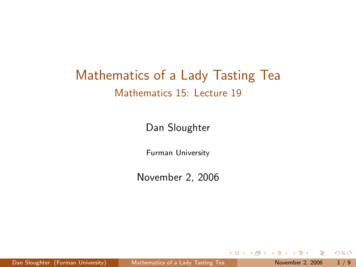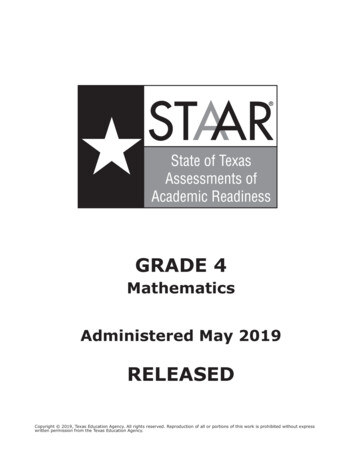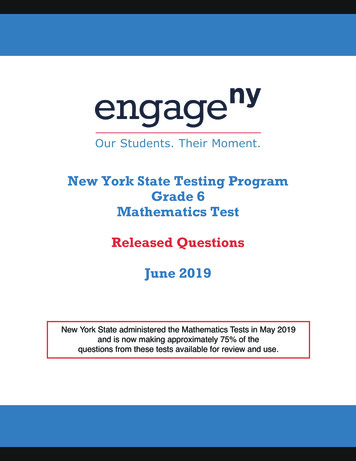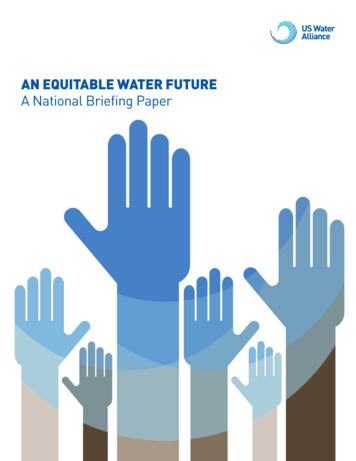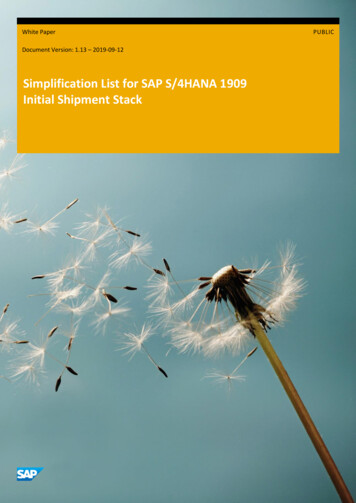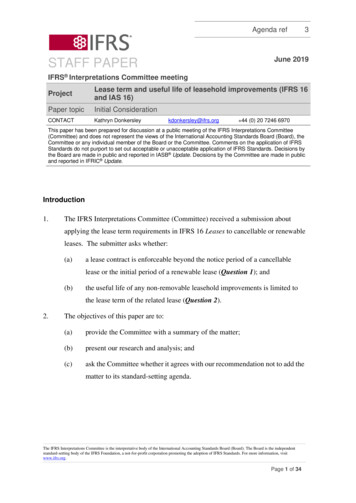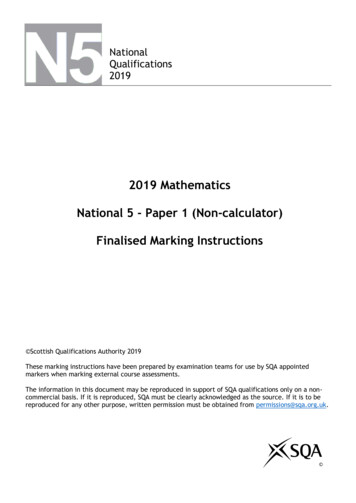
Transcription
NationalQualifications20192019 MathematicsNational 5 - Paper 1 (Non-calculator)Finalised Marking Instructions Scottish Qualifications Authority 2019These marking instructions have been prepared by examination teams for use by SQA appointedmarkers when marking external course assessments.The information in this document may be reproduced in support of SQA qualifications only on a noncommercial basis. If it is reproduced, SQA must be clearly acknowledged as the source. If it is to bereproduced for any other purpose, written permission must be obtained from permissions@sqa.org.uk.
General marking principles for National 5 MathematicsAlways apply these general principles. Use them in conjunction with the detailed markinginstructions, which identify the key features required in candidates’ responses.For each question, the marking instructions are generally in two sections: generic scheme — this indicates why each mark is awardedillustrative scheme — this covers methods which are commonly seen throughout the markingIn general, you should use the illustrative scheme. Only use the generic scheme where a candidatehas used a method not covered in the illustrative scheme.(a)Always use positive marking. This means candidates accumulate marks for the demonstration ofrelevant skills, knowledge and understanding; marks are not deducted for errors or omissions.(b)If you are uncertain how to assess a specific candidate response because it is not covered by thegeneral marking principles or the detailed marking instructions, you must seek guidance fromyour team leader.(c)One mark is available for each . There are no half marks.(d)If a candidate’s response contains an error, all working subsequent to this error must still bemarked. Only award marks if the level of difficulty in their working is similar to the level ofdifficulty in the illustrative scheme.(e)Only award full marks where the solution contains appropriate working. A correct answer withno working receives no mark, unless specifically mentioned in the marking instructions.(f)Candidates may use any mathematically correct method to answer questions, except in caseswhere a particular method is specified or excluded.(g)If an error is trivial, casual or insignificant, for example 6 x 6 12, candidates lose theopportunity to gain a mark, except for instances such as the second example in point (h) below.page 02
(h)If a candidate makes a transcription error (question paper to script or within script),they lose the opportunity to gain the next process mark, for exampleThis is a transcription error and sothe mark is not awarded.x2 5 x 7 9 x 4x 4x 3 0This is no longer a solution of aquadratic equation, so the mark isnot awarded.x 1The following example is an exception to the abovex2 5 x 7 9 x 4This error is not treated as atranscription error, as thecandidate deals with the intendedquadratic equation. The candidatehas been given the benefit of thedoubt and all marks awarded.(i)x 4x 3 0( x 3)( x 1) 0x 1 or 3Horizontal/vertical markingIf a question results in two pairs of solutions, apply the following technique, but only ifindicated in the detailed marking instructions for the question.Example: 5 6 x 2 x 4 6 y 5 y 75Horizontal: 5 x 2 and x 4 6 y 5 and y 7Vertical: 5 x 2 and y 5 6 x 4 and y 7You must choose whichever method benefits the candidate, not a combination of both.(j)In final answers, candidates should simplify numerical values as far as possible unlessspecifically mentioned in the detailed marking instruction. For example1551must be simplified toor 1124415must be simplified to 500·343must be simplified to 43145 must be simplified to 415364 must be simplified to 8**The square root of perfect squares up to and including 100 must be known.page 03
(k)Commonly Observed Responses (COR) are shown in the marking instructions to help markcommon and/or non-routine solutions. CORs may also be used as a guide when markingsimilar non-routine candidate responses.(l)Do not penalise candidates for any of the following, unless specifically mentioned in thedetailed marking instructions: working subsequent to a correct answercorrect working in the wrong part of a questionlegitimate variations in numerical answers/algebraic expressions, for example anglesin degrees rounded to nearest degreeomission of unitsbad form (bad form only becomes bad form if subsequent working is correct), forexample( x3 2 x 2 3 x 2)(2 x 1) written as( x 3 2 x 2 3 x 2) 2 x 1 2 x 4 5 x3 8 x 2 7 x 2gains full credit repeated error within a question, but not between questions or papers(m) In any ‘Show that ’ question, where candidates have to arrive at a required result, thelast mark is not awarded as a follow-through from a previous error, unless specified inthe detailed marking instructions.(n)You must check all working carefully, even where a fundamental misunderstanding isapparent early in a candidate’s response. You may still be able to award marks later inthe question so you must refer continually to the marking instructions. The appearanceof the correct answer does not necessarily indicate that you can award all the availablemarks to a candidate.(o)You should mark legible scored-out working that has not been replaced. However, if thescored-out working has been replaced, you must only mark the replacement working.(p)If candidates make multiple attempts using the same strategy and do not identify theirfinal answer, mark all attempts and award the lowest mark. If candidates try differentvalid strategies, apply the above rule to attempts within each strategy and then awardthe highest mark.For example:Strategy 1 attempt 1 is worth 3marks.Strategy 2 attempt 1 is worth 1 mark.Strategy 1 attempt 2 is worth 4marks.Strategy 2 attempt 2 is worth 5marks.From the attempts using strategy 1,the resultant mark would be 3.From the attempts using strategy 2,the resultant mark would be 1.In this case, award 3 marks.page 04
Marking instructions for each questionGeneric schemeQuestion1.Illustrative scheme3 1 substitute into 5x3 1 5 2 or equivalent 2 evaluate 5x3 2 40Notes:1. Correct answer without working award 2/22. Accept 5 23 for 13. For subsequent incorrect working, 2 is not availableCommonly observed responses:1. 1000 [(5 2)3 ] (no working necessary)award 1/2 2. (a) 2 5 ( 2)3 2 40award 2/2(b) 2 5 ( 2)3 2 40 x 38award 1/2 3. 5 23 40award 0/224. 5 2 20award 0/2page 05Maxmark2
Generic schemeQuestionIllustrative scheme2.start to multiply fractions 1 2 consistent answer in simplestform 21 23 128 Maxmark7914Notes:1. Correct answer without workingaward 0/22. 2 is only available where simplifying is required3. For subsequent incorrect working, 2 is not available3 12 95 1eg 8 7 1414award 1/2 Commonly observed responses:1.3 128 2. (a)(b)3.73 3678 123 7 award 1/2 568 12 7award 1/2 3221award 0/296 1 start to expand 1 evidence of any 3 correct termseg 2 x 7 x 3 x32 2 complete expansion 2 2 x 7 x 3 x 10 x 35 x 15 3 collect like terms (which mustinclude a term in x3) 3 2 x 3 x 38 x 1533222Notes:1. Correct answer without workingaward 3/32. For subsequent incorrect working, 3 is not availableCommonly observed responses:page 063
Generic schemeQuestion4.Illustrative schemeMethod 1Method 1 1 appropriate fraction 1 2 consistent substitution intoappropriate formula 2 3 calculate length of arc 3 125·6 (cm)Method 2Method 2 1 appropriate fraction 12 consistent substitution intoappropriate formula 22403602403602403602403603or equivalent 3·14 60or equivalent arc3 14 60 3 125·6 (cm) 3 calculate length of arcNotes:1. Correct answer without working2. BEWARE240 2 2403603. r 120360360award 0/3240 3·14 30 2 125 6(cm) 360 3·14 302 3·14 60 62 8(cm)award 1/3 award 2/3 Commonly observed responses:1.2.3.240360360240240360 3·14 30 62 8(cm)award 2/3 3·14 60 282 6(cm)award 2/3 60 onlyaward 1/3 4. 3·14 60 188 4(cm)5.240360 r 2 240360award 0/3 3·14 302 1884(cm)award 2/3 page 07Maxmark
Question5.(a)Generic schemeIllustrative scheme 1 state median 1 5 2 find quartiles 2 3·5 and 8 3 calculate SIQR 3 2·253Notes:award 11. (a) Correct median without working(b) Correct SIQR without working, do not award 2 or 32. Accept quartiles indicated in the list or on a diagram for 23. If ‘correct’ SIQR is found from an(a) ordered list with one missing term or one extra number1 (b) unordered list Q 2 6, SIQR (7 5 5) 0 75 2 4. 2 and 3 are not available for finding12of the range ieaward 2/3 award 1/3 10 3 3 52Commonly observed responses:131.(a) Q 2 5,Q 1 4,Q3 7; SIQR (7 4) 1 5 or221(b) Q 2 5; SIQR (7 4) 1 52page 08Maxmarkaward 2/3 award 1/3
Question5.(b)Generic schemeIllustrative scheme 4 valid comment comparingmedians 4 eg On average, temperatures inGrantford are lower. 5 valid comment comparing SIQRs 5 eg Temperatures in Grantford areless consistent.Maxmark2Notes:1. Answers must be consistent with answers to part (a).eg If in part (a) the calculated median is 8 then award 4 for ‘on average the temperature is thesame in both places’ or equivalent.If in part (a) the calculated SIQR is 1 5 then award 5 for ‘the spread of temperatures is the samein both places’ or equivalent.2. Comments must refer to Grantford and/or Endoch(a) Accept eg On average the temperature in Endoch is higher and more consistent(b) Do not accept eg On average the temperature is higher and more consistent3. For the award of 4(a) Accept eg On average Grantford is colder In general Endoch is warmer(b) Do not accept eg The median temperature in Grantford is less The temperature in Endoch is more (this implies that all temperatures are more) On average Endoch’s temperature is better4. For the award of 5(a) Accept eg The spread of temperatures is more in Grantford The temperatures in Endoch are less varied(b) Do not accept eg Grantford’s SIQR is more The range of Endoch’s temperatures is less On average the temperatures in Grantford are more varied The SIQR of Grantford’s temperatures is less consistentCommonly observed responses:page 09
Generic schemeQuestion6.(a)Illustrative schemeMethod 11 use points 1 5,14 and 3 5,8 to 1find gradient2 substitute gradient and a pointinto y b m x a 3 state equation in terms of 6or equivalent2 2 eg y 8 62Maxmark3 x 3·5 3 eg F 3E 18·5F and E in simplest form(remove any brackets and collectconstants)Method 261 or equivalent 1 use points 1 5,14 and 3 5,8 to 2find gradient6 2 eg 8 3·5 c 2 substitute gradient and a point2into y mx c 3 state equation in terms ofF and E in simplest form 3 eg F 3E 18·5Notes:1. Correct answer without workingaward 0/32. 1 is not available for using points other than 1 5,14 and 3 5,8 to find the gradient3. Gradient need not be simplified for the award of 2Commonly observed responses:Working must be shown.1. y 3 x 18·52.award 2/3 y 3 xaward 1/3 33. F E 18·5116 7 3 y 7 3( x 4) F 3E 194. m 1 4(b) 4 calculate fuel consumptionaward 2/3 award 2/3 4 15·2 (km/l)1Notes:1. Consistent answer without working award 1/1, but see Note 2.2. 4 is not available where an incorrect answer in (a) is followed through to give a negative value in(b).Commonly observed responses:page 10
Generic schemeQuestion7.Illustrative schemeMethod 1Method 1 1 multiply by 2 1 2 A h x y 2 divide by h 2 3 subtract y2Ah 3 x Maxmark3 x y2Ah yMethod 2Method 2 1 multiply by 2 1 2 A h x y 2 expand bracket and subtract hy 2 2 A hy hx 3 divide by h 3 x 2 A hyhNotes:1. Correct answer without working award 0/32. Apply Method 2 instructions in cases where bracket is expanded. Candidates may do 2 followed by 13. BEWARE: check all steps in answer112 A hyeg A hx hy hx A hy hx 2 A hy x 22haward 1/3 (Method 2)4. For subsequent incorrect working 3 is not available5. Where final answer includes or sign(s), the maximum award is 2/36. Accept a final answer of x A2 hyh(working must be shown) as bad formCommonly observed responses:2a hy1. x award 3/3h2. x A12award 3/3 yaward 2/3 h13. x A hy212award 2/3 hpage 11
Question8.(a)Generic schemeIllustrative scheme 1 construct equationMaxmark 1 eg 7c 3 g 2151 2 eg 5c 4 g 2001Notes:1. Accept 7c 3 g 215 kg as bad form(b) 2 construct equationNotes:1. Accept 5c 4 g 200 kg as bad form(c) 3 eg 3 correct scalingor28c 12 g 860415c 12 g 60035c 15 g 107535c 28 g 1400 4 value for c or g 4 c 20 or g 25 5 value for g or c 5 g 25 or c 206 6 communicate answer in kilograms cement 20kg , gravel 25kgNotes:1. Correct answer without workingaward 0/42. For a solution obtained by guess and checkaward 0/43. 6 is not available if either c or g is negative4. 6 is only available where a candidate calculates values for c and g, and a conclusion containingthe words ‘cement’ and ‘gravel’ along with the correct units in both casesCommonly observed responses:page 12
Question9.(a)Generic schemeIllustrative scheme 1 x 4 1 state equation of axis ofsymmetryNotes:1. For an answer of 4 or axis of symmetry 4(b)Maxmark1award 0/1(i) 2 state the value of a 2 41(ii) 3 state the value of b 3 201Notes:Notes:1. For an answer of y 20 x 4 2award 1/1 for (i) and 1/1 for (ii)2. For answers of (i) 20 and (ii) 4 award 0/1 for (i) and 1/1 for (ii)This note only applies where the “correct” answers have been switched3. Mark (b) independently from (a)page 13
Generic schemeQuestion10.(a)Illustrative scheme1 5 1 4 1 correct answerNotes:1. Award 0/1 where:(a) brackets are omitted from the answer(b) the answer is given in coordinate form 5 as bad form 4 2. (a) Treat (b) However, foraward 1
1. Answers must be consistent with answers to part (a). eg If in part (a) the calculated median is 8 then award 4 for ‘on average the temperature is the same in both places’ or equivalent. If in part (a) the calculated SIQR is 1 5 then award 5 for ‘the spread of temperatures is the same in both places’ or equivalent. 2. Comments must .File Size: 977KBPage Count: 48

